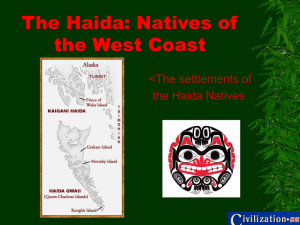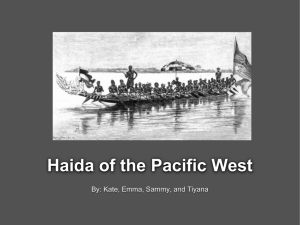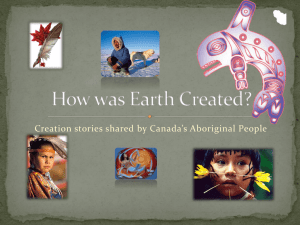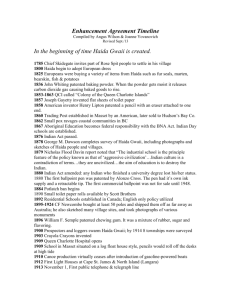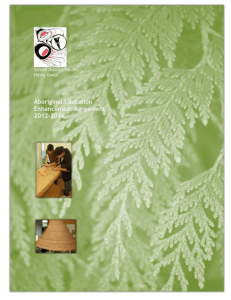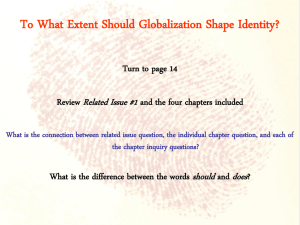ENGLISH CULTURE DAY – 2014/2015 (Teacher`s Copy) Date
advertisement
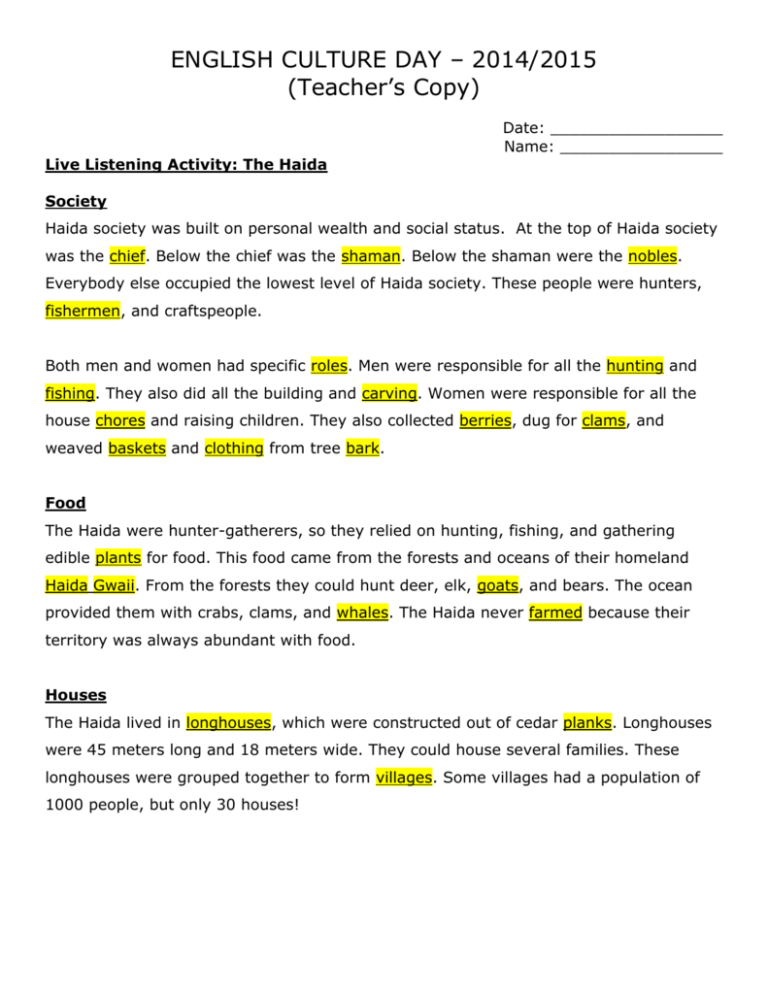
ENGLISH CULTURE DAY – 2014/2015 (Teacher’s Copy) Live Listening Activity: The Haida Date: __________________ Name: _________________ Society Haida society was built on personal wealth and social status. At the top of Haida society was the chief. Below the chief was the shaman. Below the shaman were the nobles. Everybody else occupied the lowest level of Haida society. These people were hunters, fishermen, and craftspeople. Both men and women had specific roles. Men were responsible for all the hunting and fishing. They also did all the building and carving. Women were responsible for all the house chores and raising children. They also collected berries, dug for clams, and weaved baskets and clothing from tree bark. Food The Haida were hunter-gatherers, so they relied on hunting, fishing, and gathering edible plants for food. This food came from the forests and oceans of their homeland Haida Gwaii. From the forests they could hunt deer, elk, goats, and bears. The ocean provided them with crabs, clams, and whales. The Haida never farmed because their territory was always abundant with food. Houses The Haida lived in longhouses, which were constructed out of cedar planks. Longhouses were 45 meters long and 18 meters wide. They could house several families. These longhouses were grouped together to form villages. Some villages had a population of 1000 people, but only 30 houses! Art Woodworking, particularly carving, was an art form passed down from generation to generation. The Haida made totem poles, canoes, sculptures, and masks. The Haida also viewed weaving as an art form. Thanks to their skill in weaving, they were able to make hats, skirts, cloaks, baskets, and many other things they could both use and trade. Religion The Haida worshipped spirits. Spirits were connected to all living things. The only link between the spirit world and the natural world was the shaman. A shaman could be a man or woman. They were responsible for curing the sick and communicating with the spirit world to ensure there was balance and harmony in the natural world. The Potlatch The Potlatch (meaning ‘to give’) was the most important cultural ceremony for the Haida. These celebrations sometimes took more than one year to plan. The ceremony usually occurred during times of great change in a person’s life: marriage, birth, death, and coming of age. It included speeches, feasting, singing, costumed dancing, and gift giving. Some potlatches lasted as long as three weeks! Interpreting History: Quotes ‘We will dance when our laws command us to dance, we will feast when our hearts desire to feast. Do we ask the white man, 'Do as the Indian does'? No, we do not. Why, then, will you ask us, 'Do as the white man does'? It is a strict law that bids us to dance. It is a strict law that bids us to distribute our property among our friends and neighbours. It is a good law. Let the white man observe his law; we shall observe ours. And now, if you are come to forbid us to dance, begone; if not, you will be welcome to us.’ - Chief O'waxalagalis describes the potlatch to anthropologist Franz Boas. 1) Write a 75 word reflective analysis on the quote above. Think about the presentation earlier today: the significance of culture and identity; the Potlatch ban; the relationships between First Nations and Europeans; as well as the richness of aboriginal cultures. Discussion Questions: 1) What is an aboriginal? -People inhabiting or existing in a land before the arrival of colonists. 2) Why were the borders between First Nations never clearly defined? -Aboriginal people believed that their relationship to the land was more spiritual than it was political. Land was valuable insofar as it contained resources that each band valued, however there is no evidence of clearlydefined borders. Aboriginal cultures understood that land was subject to change and that it was only borrowed. 3) Were First Nations trade routes extensive or not? What does this say about early aboriginal cultures? -Valuables belonging to Pacific Northwest peoples have been found as far east as Manitoba, which is halfway across Canada. This shows that aboriginal cultures had complex trade networks and that they had a surplus of artisan goods that could be traded. 4) Haida society was prosperous. What four factors contributed to this success and what was the result? -Isolation. The Haida lived on island fortresses that were difficult to reach. This gave the Haida people security. -Abundance and diversity of foods. The Haida had access to plenty of diverse foods, which meant that not only did they not starve, but their diet was extremely healthy. -Skilled raiders. The Haida would execute lightning attacks on the villages of their enemies. They were raiding for precious shells, stones, copper, and slaves. Their skill and unpredictability in war, meant that their enemies focused more on defending themselves against the Haida, rather than counter-attacking the Haida. -Organized labour. Haida society was hierarchical – it was a class system, which dictated everybody’s specific role. This meant that everybody knew what they had to do in order for the band to survive. In times of prosperity, the Haida would use slaves to do the hardest labour, which opened time for them to focus on more artistic pursuits such as carving, painting, weaving, and woodworking. 5) What was your favourite part of the presentation? -Inform students that they will be given 5-10 minutes to formulate an answer, before the class regroups to share ideas. This is supposed to be a reflective exercise on what the students have learned.




